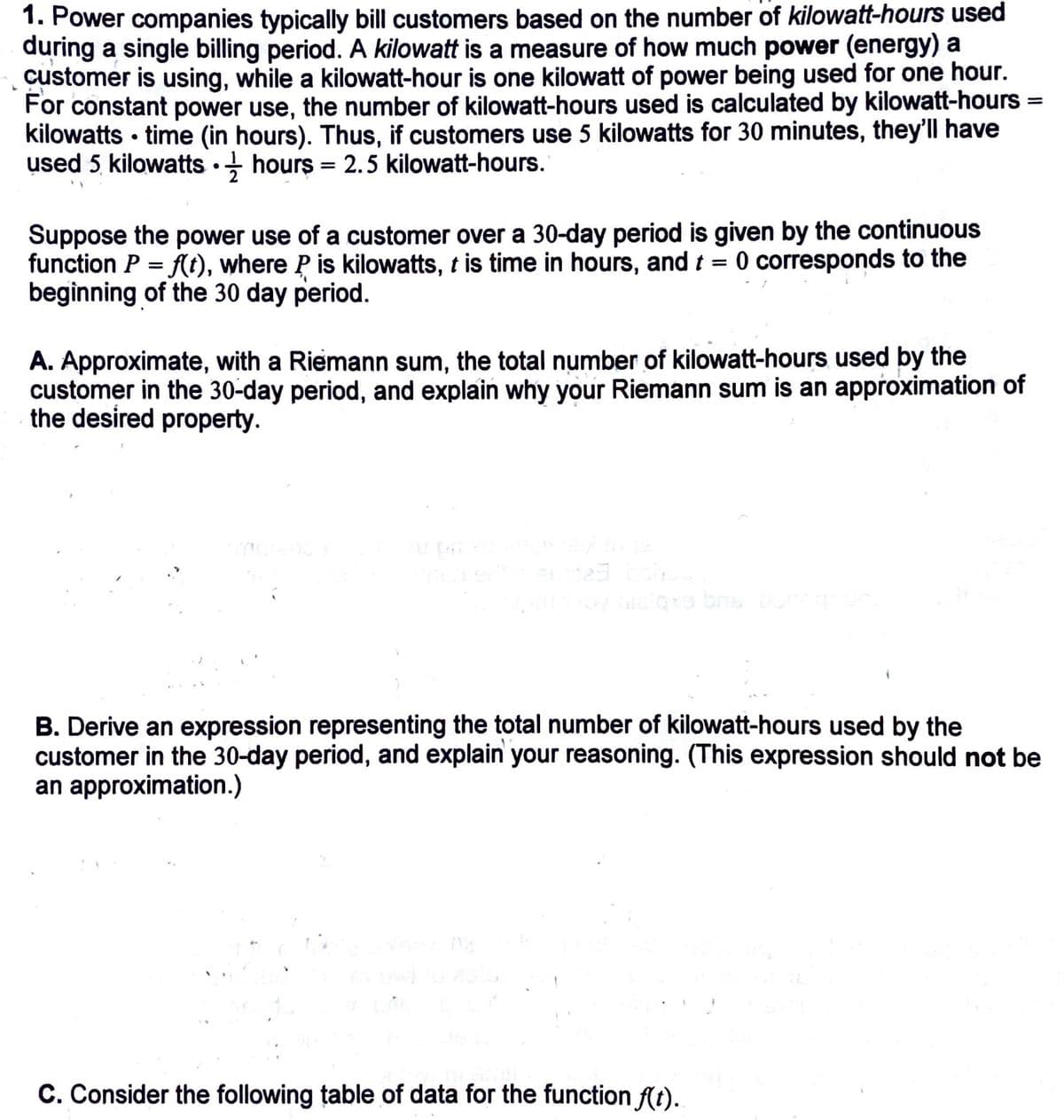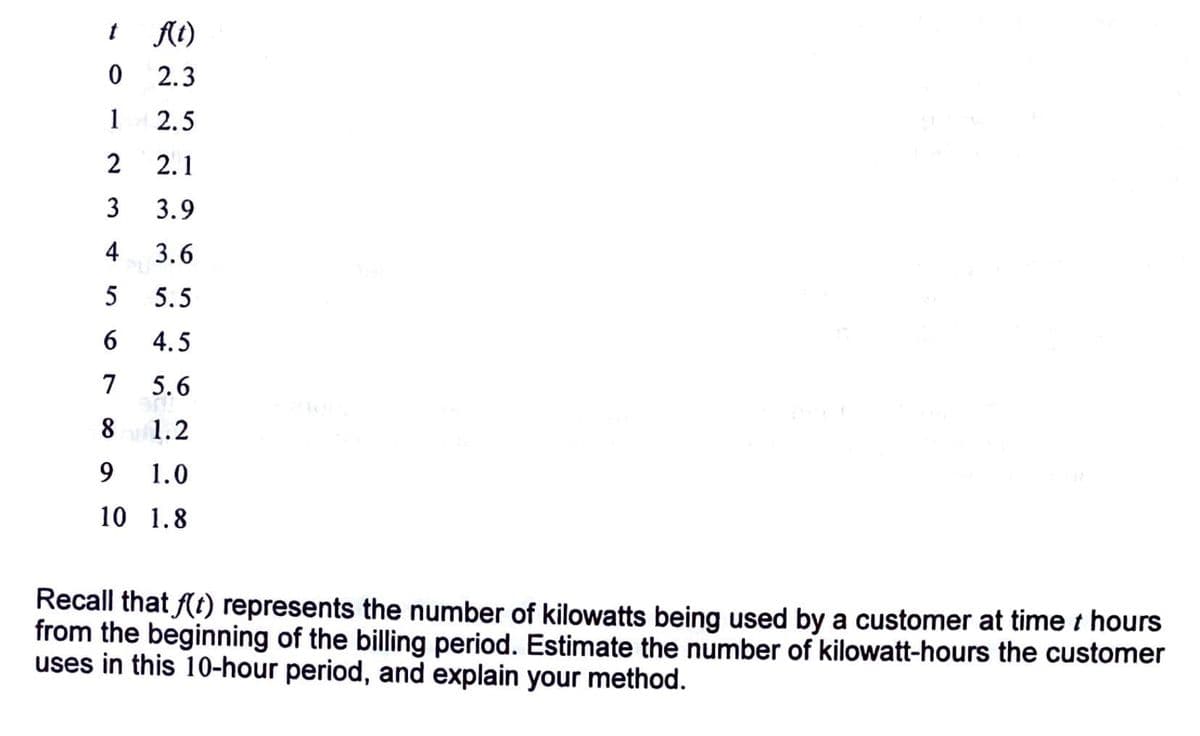1. Power companies typically bill customers based on the number of kilowatt-hours sed during a single billing period. A kilowatt is a measure of how much power (energy) a customer is using, while a kilowatt-hour is one kilowatt of power being used for one hour. For constant power use, the number of kilowatt-hours used is calculated by kilowatt-hours kilowatts time (in hours). Thus, if customers use 5 kilowatts for 30 minutes, they'll have used 5 kilowatts-hours = 2.5 kilowatt-hours. ● Suppose the power use of a customer over a 30-day period is given by the continuous function P = f(t), where P is kilowatts, t is time in hours, and t = 0 corresponds to the beginning of the 30 day period. A. Approximate, with a Riemann sum, the total number of kilowatt-hours used by the customer in the 30-day period, and explain why your Riemann sum is an approximation of the desired property. B. Derive an expression representing the total number of kilowatt-hours used by the customer in the 30-day period, and explain your reasoning. (This expression should not be an approximation.) C. Consider the following table of data for the function f(t).
1. Power companies typically bill customers based on the number of kilowatt-hours sed during a single billing period. A kilowatt is a measure of how much power (energy) a customer is using, while a kilowatt-hour is one kilowatt of power being used for one hour. For constant power use, the number of kilowatt-hours used is calculated by kilowatt-hours kilowatts time (in hours). Thus, if customers use 5 kilowatts for 30 minutes, they'll have used 5 kilowatts-hours = 2.5 kilowatt-hours. ● Suppose the power use of a customer over a 30-day period is given by the continuous function P = f(t), where P is kilowatts, t is time in hours, and t = 0 corresponds to the beginning of the 30 day period. A. Approximate, with a Riemann sum, the total number of kilowatt-hours used by the customer in the 30-day period, and explain why your Riemann sum is an approximation of the desired property. B. Derive an expression representing the total number of kilowatt-hours used by the customer in the 30-day period, and explain your reasoning. (This expression should not be an approximation.) C. Consider the following table of data for the function f(t).
Introductory Circuit Analysis (13th Edition)
13th Edition
ISBN:9780133923605
Author:Robert L. Boylestad
Publisher:Robert L. Boylestad
Chapter1: Introduction
Section: Chapter Questions
Problem 1P: Visit your local library (at school or home) and describe the extent to which it provides literature...
Related questions
Question

Transcribed Image Text:1. Power companies typically bill customers based on the number of kilowatt-hours used
during a single billing period. A kilowatt is a measure of how much power (energy) a
customer is using, while a kilowatt-hour is one kilowatt of power being used for one hour.
For constant power use, the number of kilowatt-hours used is calculated by kilowatt-hours
kilowatts • time (in hours). Thus, if customers use 5 kilowatts for 30 minutes, they'll have
used 5 kilowatts-hours = 2.5 kilowatt-hours.
Suppose the power use of a customer over a 30-day period is given by the continuous
function P = f(t), where P is kilowatts, t is time in hours, and t = 0 corresponds to the
beginning of the 30 day period.
A. Approximate, with a Riemann sum, the total number of kilowatt-hours used by the
customer in the 30-day period, and explain why your Riemann sum is an approximation of
the desired property.
A Nova
B. Derive an expression representing the total number of kilowatt-hours used by the
customer in the 30-day period, and explain your reasoning. (This expression should not be
an approximation.)
C. Consider the following table of data for the function f(t).

Transcribed Image Text:t
f(t)
0 2.3
1
2.5
2
2.1
3
3.9
4
3.6
5
5.5
6
4.5
7
5.6
8
1.2
9
1.0
10 1.8
Recall that f(t) represents the number of kilowatts being used by a customer at time t hours
from the beginning of the billing period. Estimate the number of kilowatt-hours the customer
uses in this 10-hour period, and explain your method.
Expert Solution
This question has been solved!
Explore an expertly crafted, step-by-step solution for a thorough understanding of key concepts.
This is a popular solution!
Trending now
This is a popular solution!
Step by step
Solved in 2 steps

Knowledge Booster
Learn more about
Need a deep-dive on the concept behind this application? Look no further. Learn more about this topic, electrical-engineering and related others by exploring similar questions and additional content below.Recommended textbooks for you

Introductory Circuit Analysis (13th Edition)
Electrical Engineering
ISBN:
9780133923605
Author:
Robert L. Boylestad
Publisher:
PEARSON

Delmar's Standard Textbook Of Electricity
Electrical Engineering
ISBN:
9781337900348
Author:
Stephen L. Herman
Publisher:
Cengage Learning

Programmable Logic Controllers
Electrical Engineering
ISBN:
9780073373843
Author:
Frank D. Petruzella
Publisher:
McGraw-Hill Education

Introductory Circuit Analysis (13th Edition)
Electrical Engineering
ISBN:
9780133923605
Author:
Robert L. Boylestad
Publisher:
PEARSON

Delmar's Standard Textbook Of Electricity
Electrical Engineering
ISBN:
9781337900348
Author:
Stephen L. Herman
Publisher:
Cengage Learning

Programmable Logic Controllers
Electrical Engineering
ISBN:
9780073373843
Author:
Frank D. Petruzella
Publisher:
McGraw-Hill Education

Fundamentals of Electric Circuits
Electrical Engineering
ISBN:
9780078028229
Author:
Charles K Alexander, Matthew Sadiku
Publisher:
McGraw-Hill Education

Electric Circuits. (11th Edition)
Electrical Engineering
ISBN:
9780134746968
Author:
James W. Nilsson, Susan Riedel
Publisher:
PEARSON

Engineering Electromagnetics
Electrical Engineering
ISBN:
9780078028151
Author:
Hayt, William H. (william Hart), Jr, BUCK, John A.
Publisher:
Mcgraw-hill Education,